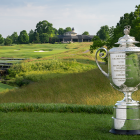
Sometimes I think we get a little lost in the data of professional golf. It's easy to do. There's a lot of it. We holler about strokes gained and driving distance and all manner of things, but we lose sight of the broader context. What those numbers mean based on the past and the future.
To provide a little bit of that context and maybe shine a light on the kind of season various players are having, I parsed through some strokes gained data from the last 15 years. I took the average of different players in three categories -- strokes gained total, strokes gained tee to green and strokes gained putting -- and then found the best and worst seasons compared to those players' average.
So let's say Tiger Woods' career average strokes gained per round is 2.0, and he's at 1.0 this season. That means he would be -1.0 worse than his career average. The results were pretty interesting, and one player in particular was fascinating. First, let's look at who is having a career year based on what they've done in the past.
- Rory McIlroy: 1.12 SG better than career average
- Patrick Cantlay: 0.91
- Lucas Glover: 0.87
- Dustin Johnson: 0.81
- Xander Schauffele: 0.79
- Adam Scott: 0.76
- Peter Malnati: 0.73
- Chez Reavie: 0.72
- Troy Merritt: 0.71
- Webb Simpson: 0.71
These make sense, right? Cantlay, who is great normally, is having an all-time great year. So is McIlroy. And those non-star names you see below them you've also seen on leaderboards in the past months. D.J. is maybe a bit of a surprise, if only because he's been fairly quiet since the PGA Championship. Also, I've been screaming about it, but Simpson has been awesome this season and really the past few seasons.
When I dove a little deeper, though, I found one player who really popped for a few reasons. That player is Jordan Spieth, who has just three top 10s on the year and one top five (at the PGA Championship).
The reason that's interesting is because Spieth is having an all-time great putting season (for him). Normally, when you give somebody of his caliber an elite putting season, that player is going to win multiple times and possibly contend for or win a major (or more). The problem? Everything else.
- +0.4 SG putting better than career average
- -1.4 SG tee to green worse than career average
That second number is astonishing. Only two golfers -- John Senden and Michael Kim -- are having worse tee-to-green seasons (compared to their career averages) than Spieth.
"I'm just trying to get a little more consistent," Spieth said on Wednesday before the Wyndham Championship. "This year's just been inconsistent for me. I've shot some really low rounds, I've putted really well, but I've just had those tee balls that are costing me a chance to win golf tournaments pretty much each week."
Spieth is 183rd on the PGA Tour in driving this year.
"Those are getting tighter, it's getting less spread out, I'm driving the ball better," he added. "Just really need to continue to do what I'm doing, not try to do anything extra special. It's not too far off. It's just, like I mentioned five, six months ago, it's just going to be a process, a building process. I feel patient with it."
If you've been following along all season and believe in this data like I do, none of this is a surprise. But that doesn't mean it still doesn't stand out when you're staring at it. Jordan Spieth, better at putting than he's maybe ever been, can't buy a top-five finish. This was highlighted last week at the WGC-FedEx St. Jude Invitational when he led the field in birdies and couldn't crack the top 10 because he made two doubles and two triples.
It's been a long, weird year for the three-time major champion, one he hopes ends on a higher note than he's hit so far. And if he can somehow get the tee to green game together, it's clear that he's ready -- at least with his putter -- to start winning golf tournaments once again.





















